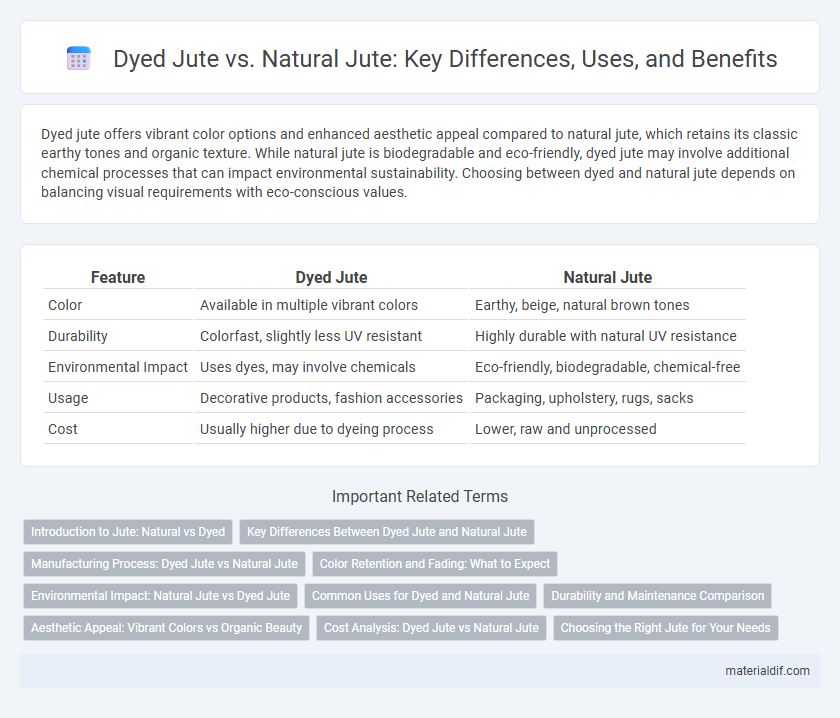Dyed jute offers vibrant color options and enhanced aesthetic appeal compared to natural jute, which retains its classic earthy tones and organic texture. While natural jute is biodegradable and eco-friendly, dyed jute may involve additional chemical processes that can impact environmental sustainability. Choosing between dyed and natural jute depends on balancing visual requirements with eco-conscious values.
Table of Comparison
| Feature | Dyed Jute | Natural Jute |
|---|---|---|
| Color | Available in multiple vibrant colors | Earthy, beige, natural brown tones |
| Durability | Colorfast, slightly less UV resistant | Highly durable with natural UV resistance |
| Environmental Impact | Uses dyes, may involve chemicals | Eco-friendly, biodegradable, chemical-free |
| Usage | Decorative products, fashion accessories | Packaging, upholstery, rugs, sacks |
| Cost | Usually higher due to dyeing process | Lower, raw and unprocessed |
Introduction to Jute: Natural vs Dyed
Jute, a versatile natural fiber derived from the Corchorus plant, is widely used for eco-friendly textiles and packaging materials. Natural jute retains its earthy, golden-brown hue and is prized for its biodegradable and sustainable properties. Dyed jute undergoes color treatment to expand its aesthetic appeal, offering vibrant options for fashion and home decor while maintaining the fiber's inherent strength and durability.
Key Differences Between Dyed Jute and Natural Jute
Dyed jute undergoes a color treatment process that enhances its aesthetic appeal and expands its use in fashion and home decor, while natural jute retains its original earthy tones and organic texture, maintaining eco-friendly and biodegradable properties. The chemical or natural dyes applied to dyed jute may affect the fiber's strength and moisture absorption compared to natural jute, which is often preferred for its durability and hypoallergenic features. Cost differences arise as dyed jute generally requires additional processing and materials, making natural jute a more economical choice for industrial and craft applications.
Manufacturing Process: Dyed Jute vs Natural Jute
Dyed jute undergoes an additional coloring stage during manufacturing, where fibers are immersed in dye baths to achieve vibrant hues, followed by drying and finishing processes to ensure colorfastness. Natural jute bypasses this dyeing phase, maintaining its original beige tone through basic cleaning, retting, and drying techniques that preserve the fiber's inherent qualities. The dyeing process increases production time and complexity while offering a broad palette for decorative and industrial uses, contrasting with natural jute's eco-friendly simplicity and cost-efficiency.
Color Retention and Fading: What to Expect
Dyed jute offers vibrant color options but may experience gradual fading over time due to exposure to sunlight and washing, impacting long-term color retention. Natural jute retains its earthy, muted tone without significant color changes, providing a rustic and authentic aesthetic that resists fading but lacks variety in shade. Choosing between dyed and natural jute depends on the desired balance of vivid color presence versus enduring, low-maintenance appearance.
Environmental Impact: Natural Jute vs Dyed Jute
Natural jute has a significantly lower environmental impact compared to dyed jute due to the absence of chemical dyes and synthetic processing. The production of dyed jute often involves harmful chemicals and water-intensive processes that contribute to water pollution and increased carbon emissions. Choosing natural jute supports sustainable agriculture and reduces toxic waste, preserving soil and water quality.
Common Uses for Dyed and Natural Jute
Dyed jute is commonly used in decorative items such as tapestries, rugs, and fashion accessories where color vibrancy enhances aesthetic appeal. Natural jute is preferred for eco-friendly packaging, sacks, and agricultural products due to its durability and biodegradable properties. Both forms serve integral roles in sustainable manufacturing, with dyed jute catering to design and natural jute emphasizing practicality.
Durability and Maintenance Comparison
Dyed jute maintains high durability similar to natural jute, with color treatments designed to withstand fading and wear over time. Natural jute requires less maintenance, as it does not involve additional chemical processes, while dyed jute necessitates careful cleaning to preserve color vibrancy and prevent damage. Both types benefit from dry cleaning or gentle vacuuming, but dyed jute demands more attention to avoid discoloration or water damage.
Aesthetic Appeal: Vibrant Colors vs Organic Beauty
Dyed jute offers vibrant colors that enhance its visual appeal, making it ideal for decorative purposes and trendy home accents. Natural jute retains its organic beauty with earthy tones and a rustic texture, popular in eco-friendly and minimalist designs. The choice between dyed and natural jute depends on whether bold aesthetics or authentic, natural charm is preferred.
Cost Analysis: Dyed Jute vs Natural Jute
Dyed jute incurs higher production costs due to the additional expenses associated with dyes, water, and energy usage, making it less economical than natural jute. Natural jute remains cost-effective as it requires minimal processing and harnesses its inherent color, reducing labor and material expenses. The price disparity can significantly impact large-scale procurement decisions within the textile and packaging industries.
Choosing the Right Jute for Your Needs
Choosing between dyed jute and natural jute depends on the intended application and aesthetic preference. Dyed jute offers vibrant, customizable colors ideal for decorative items and fashion accessories, while natural jute provides a rustic texture and eco-friendly appeal suited for packaging, rugs, and upholstery. Consider durability, environmental impact, and the desired appearance to select the right type of jute for your specific needs.
Dyed Jute vs Natural Jute Infographic

 materialdif.com
materialdif.com